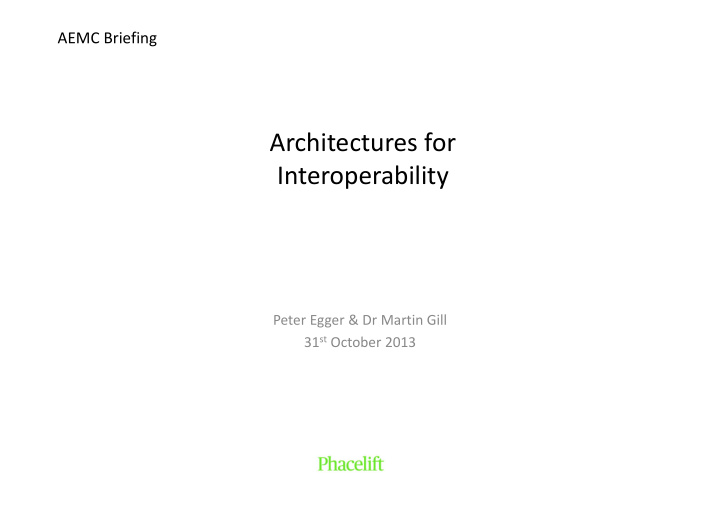



AEMC Briefing Architectures for Interoperability Peter Egger & Dr Martin Gill 31 st October 2013
AEMC Workshop Agenda 1. Possible Architectures as Interoperability moves through Not Interoperable Protocol Translation Common Protocol Interchangeable 2. Examples 3. Questions 4. Appendix ‐ Interoperability Spectrum Architectures for Interoperability v01 2
AEMC Workshop Architectures (1) The Power of Choice What level of Interoperability and Access is required to support the aims of the Power of Choice (PoC)? Direct Access Access Spectrum ? Advanced Functions Metrology Functions Closed Not Interoperable Protocol Translation Common Protocol Interchangeable Interoperability Spectrum Architectures for Interoperability v01 3
AEMC Workshop Architectures (2) Not Interoperable Accredited Parties must develop a custom Application for each Smart Meter Operator with which they wish to communicate Architectures for Interoperability v01 4
AEMC Workshop Architectures (3) Protocol Translation – No Common Meter Protocol Smart Meter Operator translates a Who defines the common “market” protocol to the common “Market” protocol supported by their meters protocol? Common Market Protocol Accredited Parties must develop a Meter Protocols are custom Application not interoperable supporting the common “market” Smart Meter Operator free to choose their own protocol meter protocol Assumes that the common market protocol is Australian Specific Architectures for Interoperability v01 5
AEMC Workshop Architectures (4) Protocol Translation – Common Meter Protocol Two protocols Smart Meter Operator translates a common meter protocol common “market” protocol to the • common meter protocol • common market protocol Development of the common market protocol is simplified by the common meter protocol Common Market Protocol Accredited Parties must develop a Meter Protocols are custom Application interoperable supporting the common “market” Smart Meter Operators are required to use a protocol common meter protocol Assumes that the common market protocol is Australian Specific Architectures for Interoperability v01 6
AEMC Workshop Architectures (5) Common Protocol – End ‐ to ‐ end Proprietary All participants are limited to those vendors prepared to support the end ‐ to ‐ end proprietary protocol Accredited Parties likely to require a Meter Protocols are custom Application interoperable to implement the chosen end ‐ to ‐ end Smart Meter Operators are required to use a protocol common meter protocol Architectures for Interoperability v01 7
AEMC Workshop Architectures (6) Common Protocol – End ‐ to ‐ End Open & Non ‐ Proprietary Standard solutions are available from a range of vendors Standard Application or may even be able Meter Protocols are to use solutions interoperable hosted remotely Meter protocol supported by a range of vendors Architectures for Interoperability v01 8
AEMC Workshop Architectures (7) Interchangeable To make meters interchangeable there is a requirement to develop a comprehensive Companion Specification in addition to the end ‐ to ‐ end protocol Interchangeable meters are either limited to the same communication technology or support a common hardware interface allowing different communications technologies to be plugged in (e.g. for geographic areas). Refer SMI FS Function 19 (Work ‐ in ‐ progress) Architectures for Interoperability v01 9
AEMC Workshop Some Examples Architectures for Interoperability v01 10
AEMC Workshop Examples (1) Victoria – Example of Protocol Translation The distributor has offered a protocol to retailers After accepting the protocol the retailer must develop custom software to support the distributor’s protocol Architectures for Interoperability v01 11
AEMC Workshop Examples (2) Victoria (cont) While Victoria provides an example of protocol translation the lack of a common market protocol results in the end ‐ to ‐ end interaction falling between Not Interoperable and Protocol Translation Without a market protocol Retailers may have to implement a different interface (protocol translation) for each distributor Architectures for Interoperability v01 12
AEMC Workshop Examples (3) New Zealand In New Zealand the Smart Meter Operator must implement suitable protocols for the retailers. Without a common protocol each smart meter operator may have to implement a different interface (with protocol translation) for each retailer Architectures for Interoperability v01 13
AEMC Workshop Examples (4) Protocol Translation ‐ Steps to add new functionality FRMP offers a customer a smart meter with New Functionality (“set a fixed daily budget”) SMO chooses meter vendor FRMP and SMO negotiate FRMP and SMO update their SMO contracts with the with a solution supporting protocol translators to support changes to protocol to support communications vendor to All of these changes must be undertaken for EACH new function new functionality. new functionality. the agreed protocol implement changes needed Restriction: must work with to support new functionality the selected SMCN Architectures for Interoperability v01 14
AEMC Workshop Examples (5) Common Protocol ‐ Adding new functionality FRMP offers a customer a smart meter with New Functionality (“set a fixed daily budget”) FRMP offering the new SMO finds a meter vendor functionality updates their with a solution supporting back office new functionality. Restriction: Must support the Common Protocol Architectures for Interoperability v01 15
AEMC Workshop Questions Architectures for Interoperability v01 16
AEMC Workshop Appendix Architectures for Interoperability v01 17
AEMC Workshop Interoperability Interoperability Spectrum Not Interchangeable Protocol Common Interoperable Translation Protocol Not Interoperable - No ability to interact with the meter (e.g. Unpublished proprietary protocol) Protocol Translation - Able to interact with the meter by converting protocols, however there may be some loss of functionality e.g. Itron MV90 is only able to read meter data it cannot alter meter settings Common Protocol - All meters use a common protocol so Accredited Parties are able to interact with all meters without loss of functionality (may offer different functionality) Interchangeable - One meter can be swapped with another with no system impacts. No need to change Head End Systems or communications (also referred to as “Fully Interoperable”) From AEMC Terms of Reference: “The communication standard specifies the technical requirements of the communication network, in particular the form of the commands sent to the meter and the information conveyed back from the meter.” This is described as the meter protocol Architectures for Interoperability v01 18
Recommend
More recommend